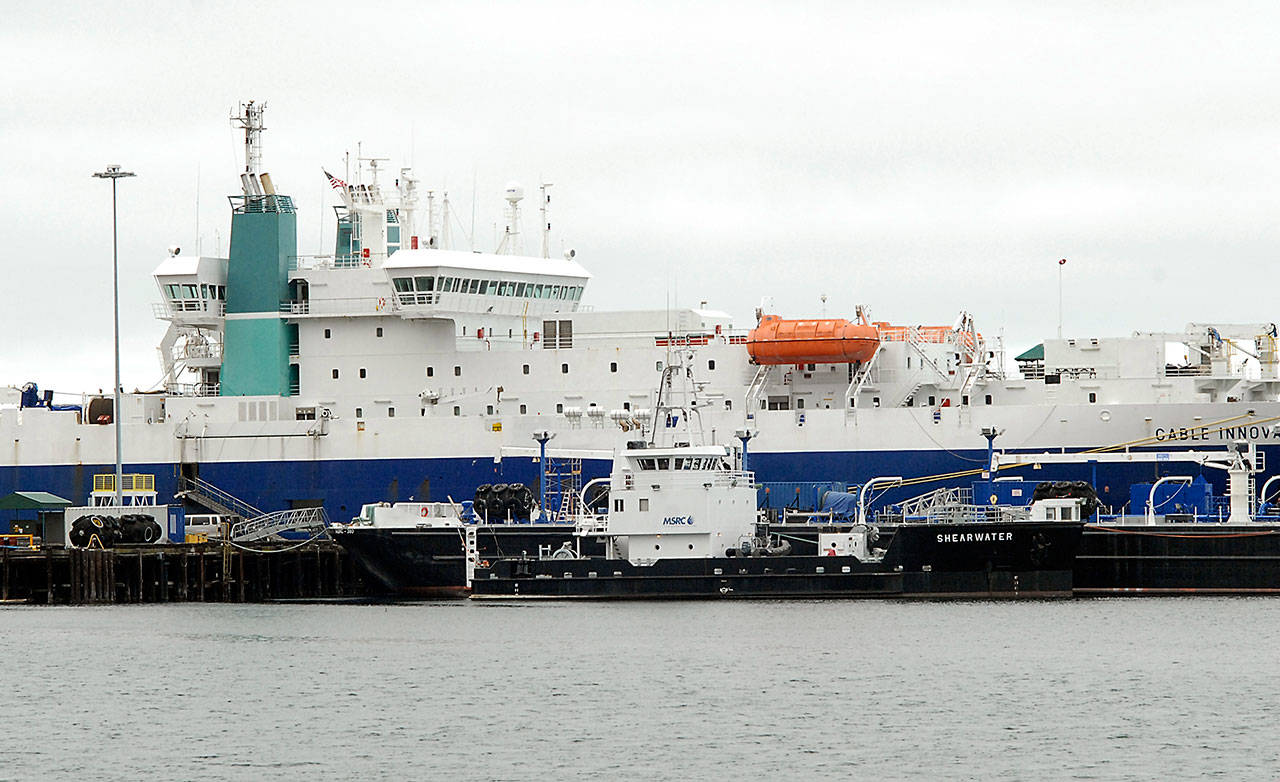CABLE INNOVATOR, THE 476-foot cable layer, has been in Port Angeles for the past couple of weeks.
The vessel is typically moored in Victoria as she is the station ship for Global Marine Systems North Pacific that has a contract with various telecommunication companies to make repairs as necessary to the numerous fiber optic cables that crisscross the Pacific Ocean.
The vessel had to leave Victoria because the entire crew consists of foreign seafarers and Canadian Immigration has a regulation requiring their periodic departure from Canadian soil. As a consequence they will be here for about a month.
I met with and spoke to the captain of the ship a few months ago and a couple of features about Port Angeles made us an attractive option when they had to leave Victoria to comply with Immigration regulations: First and foremost the vessel and crew are still close enough to the contract area to be able to respond timely should a repair issue rear its ugly head and secondly the Port has shore power available for the vessel.
In the past the ship had to move out to an anchorage which meant the engines and generators were running all the time. As time goes on expect their visits to become more commonplace.
The weather this week doesn’t seem to be able to make up its mind; some mornings it was raining other mornings the western sky was a brilliant red that reminded me of my Granny Carlow’s old saying, “Red sky at night is a sailor’s delight, red sky in the morning is a sailor’s warning.”
This proverb has been around in one form or another for more than 20 centuries. At one time farmers and sailors relied on it to plant crops and navigate ships.
Weather typically moves from west to east, propelled by the westerly trade winds.
The colors we see in the sky are due to the rays of sunlight being split into the colors of the spectrum as they pass through the atmosphere and ricochet off the water vapor and particles in the atmosphere.
The amount of water vapor and dust particles in the atmosphere are good indicators of weather conditions. They also determine which colors we will see in the sky.
During sunrise and sunset, the sun is low in the sky and transmits light through the thickest part of the atmosphere. A red sky suggests an atmosphere loaded with dust and moisture particles.
We see the red because red wavelengths (the longest in the color spectrum) are breaking through the atmosphere. The shorter wavelengths, such as blue, are scattered and broken up. When we see a red sky at night, it means that the setting sun is sending its light through a high concentration of dust particles. This usually indicates high pressure and stable air coming in from the west. Good weather generally follows.
A red sunrise reflects the dust particles of a weather system that has just passed from the west. This indicates that a storm system may be moving to the east.
If the morning sky is a deep fiery red, there is a high water content in the atmosphere. So, rain is likely on the way.
Although this age-old adage has withstood the test of time, in reality it is more of an indicator of impending weather change than an accurate predictor of rain.
New Face, a 616-foot cargo ship, moored to the Port of Port Angeles’ Terminal 3 on Wednesday night to take on a load of debarked logs that were harvested off private land in Western Washington.
She is scheduled to depart on Thursday for China with approximately 6 million board feet of logs.
Monday Tesoro Petroleum provided bunkers to New Able a 620 foot Panamanian flagged bulk cargo ship.
Tuesday, the 99-foot tug Brian S towed the 210-foot HMS 2000 tank barge, more commonly known in this column as Tesoro’s refueling barge to Point Wells where she was loaded with 394,800 gallons of black oil and 226,800 gallons of diesel, all of which was brought back to Port Angeles to replenish the stock in Tesoro’s tanks.
_________
David G. Sellars is a Port Angeles resident and former Navy boatswain’s mate who enjoys boats and strolling the area’s waterfronts and boat yards.
Items and questions involving boating, marina and industrial activities and the North Olympic Peninsula waterfronts are always welcome. News announcements about boating groups, including yacht clubs and squadrons, are welcome as well.
Email dgsellars@hotmail.com or phone him at 360-808-3202.
